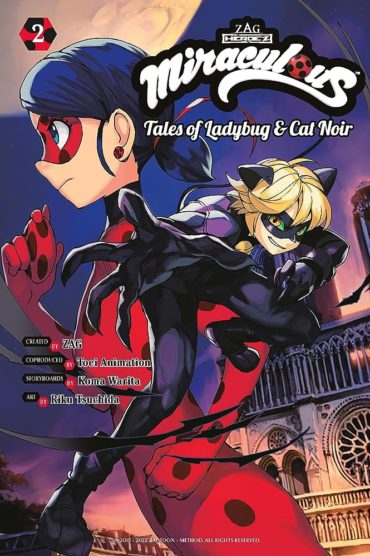Miraculous: Tales of Ladybug and Cat Noir (Manga) Volume 2 Review
Marinette and Adrien seem like ordinary teenagers but are actually Ladybug and Cat Noir – superheroes who swear to defend Paris from Hawkmoth, who has the power to channel negative emotions and change people into supervillains. Hawkmoth wants Ladybug and Cat Noir’s Miraculouses, as combining them will grant him one wish that will change the world. But with Hawkmoth starting to suspect his own son is Cat Noir, can he be closer to his goals than he realises?
Volume 2 of the Miraculous manga contains the last two parts of Evillustrator and all three parts of Dark Cupid, both episodes from Season 1 of the original series. But like the first volume, there’s tweaks made along the way to give the manga version of events a different flavour from the original cartoon. In the first volume, we already had Hawkmoth’s identity revealed, as well as his first suspicion that his own son is Cat Noir, his nemesis, due to Adrien suddenly wearing a new ring. The suspicion of Gabriel/Hawkmoth’s son is continued the first few pages of this book, where Adrien manages to sway his dad’s doubts by saying that he’s allowed to ‘accessorise’ however he likes. It’s a simple, throwaway line in the moment, but in retrospective is a good foreshadowing for the monster that Gabriel sends up becoming in the series (outside of his evil villain costume). If you haven’t seen up to Season 5, I will be light on spoilers; but THE deeper in the series we go, Gabriel’s need to control his son’s life, image, friendships, romances and more, spirals out of control. So, a simple thing like drawing his attention to Adrien’s new ring, and automatically assuming it’s for nefarious reasons (even though his suspicions are correct) is a great and subtle way to show that Gabriel dislikes it when his son tries to be his own person, with his own tastes. He can only see Adrien as an extension of himself or an enemy, nothing else. The suspicion of Adrien carries over into the Dark Cupid arc, but this time from Marinette/Ladybug herself, when she realises that Cat Noir and Adrien seem to smell the same, wearing the same cologne. It’s only later into the manga that it takes an early cameo from Luka (who in the original series, didn’t appear until midway through Season 2) to sway her suspicious when he says that a sample of the cologne has been given out as a freebie due to its popularity. Admittedly Luka is one of my favourite characters from the show, but I loved seeing him early in manga form and his cameo is a funny foreshadowing as to how important he is, not just to Marinette as a potential love interest, but as a mediator to her and Adrien’s superhero identities later in the story.
A lot of Miraculous fans who try to get others into the show, tend to recommend that they ‘skip’ the first season, and there’s some reasons as to why. The first season is very episodic, with little plot or connective tissue between the episodes, with the status quo being reset at the end of each episode. But there is a lot of material to enjoy in Season 1. Whilst it’s nice that the manga version is setting up clues to bigger plot threads that become important later in the show, the original Season 1 DID have a lot of subtle things that do foreshadow later events and add to the lore. For example, Evillustrator is one of the earliest examples that shows the limit of Hawkmoth’s power; before that point it was just assumed that the person Hawkmoth took over was now completely evil and under his control. However, we can see that Nathaniel (who becomes the Evillustrator) maintains some of his personality and humanity; he chooses to forgive Adrien when he apologises for dismissing his comic before, and is able to go about his own plans (to have a date with Marinette) that Hawkmoth has no control over. All Hawkmoth can do it threaten Evillustrator to take away his his powers and sends an electric jolt to him that warns of that fact, but he can’t 100% control Evillustrator’s mind and actions. This shows that Hawkmoth is an emotional manipulator, who preys on his victims (who have only, at this point, been impressionable teenagers) at their lowest point, not someone like The Purple Man from Jessica Jones who can control a person outright. This makes Hawkmoth a more sinister villain than some of his contemporaries in Magical Girl shows, and it works within the show’s lore where later we see Hawkmoth’s, and by extension, Ladybug’s powers grow.
Translation is once again provided for Kodansha by Alethea and Athena Nibley, who not only match the dialogue of the original show well, but also the translation notes provide context to some of Cat Noir’s puns. It’s nice that they both kindly explain how the pun worked in the original Japanese in the manga, how it works in the original French dub of the show AND how it works in English as well.
Miraculous: Tales of Ladybug and Cat Noir continues to be a fun adventure in manga form, with its minor touches to make the journey feel different from the original whilst also maintaining what made it fun and engaging in the first place. Topped with lovely art and fun-to-read translation notes, I look forward to seeing how this progresses into Volume 3.
Our review copy from Kodansha was supplied by Diamond Book Distributors UK.


